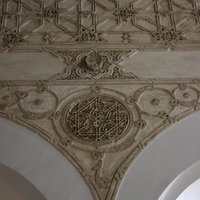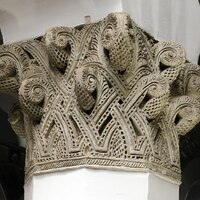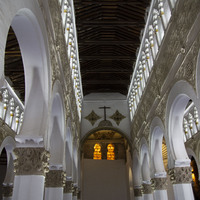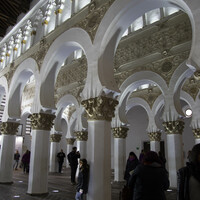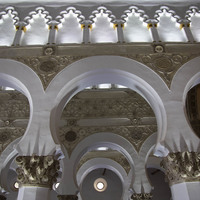Congregational synagogue of Toledo
Type:
Synagogues
Date:
Twelfth or thirteenth century
Location or Findspot (Modern-Day Country):
Spain
Description:
The oldest surviving synagogue in Toledo has an unconventional plan, with five parallel aisles and arcades with horseshoe arches. Its layout shares more in common with North African mosques (e.g., in Tinmal, Morocco) than other medieval synagogues. The capitals and surfaces above the arches are covered in geometric and vegetal motifs carved in plaster, some of which recall the surface decoration of the Great Mosque at Córdoba.
The date and patron of the synagogue are not entirely certain, but one possibility is that it was commissioned by Yosef ibn Shushan (d. 1205), the tax collector for Alfonso VIII of Castile (r. 1155–1214). A fifteenth-century manuscript that preserves a copy of his epitaph notes that he built a synagogue.
Since the early fourteenth century, the synagogue has been known as Santa María la Blanca (Saint Mary the White), the name it was given when it was turned into a church following the pogroms of 1391. With one third of Iberian Jews massacred and another third forced to convert to Christianity, many synagogues fell into disuse or were converted into churches. Santa María la Blanca now operates as a museum run by the Catholic church, which has been a source of conflict between the city's Jewish community and the archdiocese of Toledo.
The date and patron of the synagogue are not entirely certain, but one possibility is that it was commissioned by Yosef ibn Shushan (d. 1205), the tax collector for Alfonso VIII of Castile (r. 1155–1214). A fifteenth-century manuscript that preserves a copy of his epitaph notes that he built a synagogue.
Since the early fourteenth century, the synagogue has been known as Santa María la Blanca (Saint Mary the White), the name it was given when it was turned into a church following the pogroms of 1391. With one third of Iberian Jews massacred and another third forced to convert to Christianity, many synagogues fell into disuse or were converted into churches. Santa María la Blanca now operates as a museum run by the Catholic church, which has been a source of conflict between the city's Jewish community and the archdiocese of Toledo.
Relevant Textbook Chapter(s):
8
Image Credits:
Wikimedia, Linda Safran


